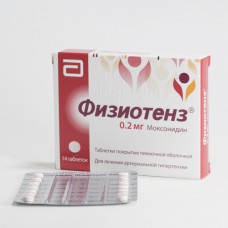Expiration date: 12/2026
The composition and form of issue:
Tablets, film-coated. 1 tablet contains:
moxonidine 0.2 mg
excipients: lactose monohydrate — that is, 95.8 mg of povidone — 0,7 mg crospovidon — 3 mg magnesium stearate — hypromellose 0.3 mg 1.3 mg ethyl cellulose 4 mg macrogol 6000 — 0.25 mg talc — 0,9975 mg iron oxide red (E172) — 0,0025 mg titanium dioxide (E171) — 1.25 mg
blistere in 14 PCs., in box 1, 2 or 7 blisters.
Tablets, film-coated. 1 tablet contains:
moxonidine 0.4 mg
excipients: lactose monohydrate — 95,6 mg povidone — 0,7 mg crospovidon — 3 mg magnesium stearate — hypromellose 0.3 mg 1.3 mg ethyl cellulose 4 mg macrogol 6000 — 0.25 mg talc — 0,875 mg iron oxide red (E172) — 0.125 mg titanium dioxide (E171) — 1.25 mg
blistere in 14 PCs., in box 1, 2 or 7 blisters.
Description pharmaceutical form:
Round, biconvex, film-coated tablets:
at a dosage of 0.2 mg — pale pink, marked "0,2" on the one hand
at a dosage of 0.4 mg — Matt-red, marked "to 0.4" on one side.
On cross-section are visible two layers.
Pharmacokinetics:
Suction
Absorption — 90%. Cmax in blood plasma (after taking tablets containing 0.2 mg of moxonidine) is 1.4–3 ng/ml and is reached after 60 min. Bioavailability of 88% (eating no effect on the pharmacokinetics).
Distribution
The volume of distribution is 1.4–3 l/kg Penetrates the GEB. The plasma protein binding of 7.2%.
Metabolism
Major metabolites: 4,5-dihydromonacolin and guanidine derivatives.
Excretion
T1/2 of moxonidine and metabolites are 2.5 and 5 h, respectively. Within 24 h more than 90% of moxonidine is excreted by the kidneys, approximately 78% unchanged and 13% dehydrogenation derived. Less than 1% is excreted in the feces. Not accumulates with prolonged use.
Pharmacokinetics in the elderly
Observed age-related changes in the pharmacokinetics associated probably with slightly higher bioavailability and/or reduced metabolic activity. However, these changes are not clinically significant.
Pharmacokinetics in renal failure
The excretion of moxonidine is heavily correlated with creatinine clearance. In patients with moderate renal insufficiency (Cl creatinine in the range of 30-60 ml/min) equilibrium concentration in plasma and the final T1/2 is approximately 2 and 1.5 times higher than in hypertensive patients with normal renal function (Cl creatinine >90 ml/min). In patients with severe renal insufficiency (Cl creatinine <30 ml/min) equilibrium concentration in plasma and the final T1/2 is 3 times higher than in persons with normal renal function. The appointment of multiple doses of the drug does not lead to cumulation in the organism of patients with moderate renal insufficiency. In the late stages in patients with severe renal insufficiency (Cl creatinine <10 ml/min), hemodialysis, equilibrium concentrations in blood plasma and the final T1/2, respectively 6 and 4 times higher than in patients with normal renal function. In patients with impaired renal function dosage should be chosen individually. Moxonidin to a small extent is excreted during hemodialysis.
Description pharmacological action:
Selectively interacting with imidazoline I1-receptors located in the brain stem and reduces sympathetic activity.
Moxonidin has a high affinity to imidazoline I1-receptors and only marginally associated with a Central ALPHA2-adrenergic receptors through the interaction with which explains the dry mouth and sedation.
Reduces the resistance of tissues to insulin.
Effect on hemodynamics: systolic and diastolic blood pressure in a single and continuous use of moxonidine is associated with a decrease in the Pressor actions of sympathetic nervous system on the peripheral vessels, decrease in peripheral vascular resistance, while cardiac output and heart rate did not significantly change.
Indications:
Hypertension.
Contraindications:
- hypersensitivity to the drug
- syndrome weakness sinusnogo hub expressed aetiology
- the age of 18 years (efficacy and safety not established).
With caution:
- severe chronic renal insufficiency and severe hepatic insufficiency (due to lack of experience)
- hemodialysis.
Application of pregnancy and breast-feeding:
Clinical data about negative influence on pregnancy no. However, care should be taken, assigning Physiotens pregnant women. During the period of treatment should stop breastfeeding, because moxonidin passes into breast milk.
Side effects:
CNS: dizziness, headache, drowsiness, sleep disturbance.
From the side of cardiovascular system: excessive lowering AD, ortostatical gipotenzia.
Gastrointestinal: dry mouth, nausea.
The skin and subcutaneous fatty tissue: skin rash, itching, angioedema.
Common: asthenia.
These symptoms usually gradually diminish during the first weeks of treatment.
Drug interactions:
Possible joint application with tiazidnymi diuretikami, ACE inhibitors and blockers of slow calcium channels. There is a mutual reinforcement in a joint application with these and other antihypertensives.
Is no pharmacokinetic interaction with hydrochlorothiazide (possible joint use), glibenclamide (glyburide), digoxin. Tricyclic antidepressants may reduce the effectiveness of antihypertensive drugs of Central action (not recommended joint appointment). Moderately increases reduced cognitive ability in patients taking lorazepam. Enhances the sedative effect of benzodiazepines. Is no pharmacodynamic interaction when administered together with moclobemide.
Method of application and dose:
Inside, regardless of the meal, the initial dose (in most cases) — 0,2 mg daily maximum daily dose of 0.6 mg (split into 2 doses) the maximum single dose — 0,4 mg
in renal failure (Cl creatinine 30-60 ml/min) and patients undergoing hemodialysis, dose — 0.2 mg, maximum daily 0.4 mg.
Overdose:
Symptoms: headache, sedation, drowsiness, excessive lowering AD, dizziness, weakness, bradycardia, dry mouth, vomiting, fatigue, and stomach pain. Potential short-term increase in blood pressure, tachycardia, hyperglycemia.
Treatment: antagonists of alpha-adrenergic receptors can reduce or eliminate paradoxical arterial hypertension. In the case of hypotension it is recommended the restoration of the BCC due to the introduction of fluid and administration of dopamine. Bradycardia can be relieved with atropine. There is no specific antidote.
Special instructions:
If you need to cancel at the same time taken beta-blockers and Physiotens first cancel beta-blockers and only a few days — Physiotens. During treatment requires regular monitoring of blood pressure, heart rate, ECG. Stop taking Physiotens gradually. Patients with rare hereditary conditions of galactose intolerance, lactase deficiency or malabsorption of glucose-galactose should not take this drug.
Data on the adverse effect of moxonidine on the ability to driving and to the management of machines and mechanisms do not exist. There are reports of drowsiness and dizziness during treatment with moxonidine. This should be considered when performing the above actions.





